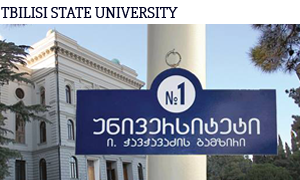
FACULTY OF HUMANITIES
Georgia Presents Versions of Shahnameh
The year of 2012 was announced as an anniversary date of one of the greatest poets, Hakim Abul-Qasim Ferdowsi Tusi (940-1020) and his immortal literary masterpiece, Shahnameh. This “Book of Kings’’ is based on historical chronicles of Persian kings, epic works, mythological stories and legends. In addition to historical information, the book contains fragments of folklore, some extracts of which were written as early as the Sasanian Period (224-651).
Despite the fact that Shahnameh is a Persian literary masterpiece, around 10 translations (Khoday Nameh- Life of the Kings) appeared in the 7th to 9th centuries. However, neither the original nor translations has survived. The Pahlavi literary sources (Al-Masudi (896-956) and Al-Istakhri (circa 850-954) have kept only the names of the translators (Ibn al-Muqaffa, Barmak) and some other details.

 One of the most significant Shahnameh research centers is at the University of Cambridge, and last year this university organized a symposium to celebrate Shahnameh’s anniversary, a date when representatives of almost all countries historically connected to the literary masterpiece delivered speeches. Georgian scientists also had a pleasure of presenting their ideas. Within the scope of the project, “Illustrated manuscripts of Shahnameh’’, supervised by Cambridge University Professor Charles Melville and Irina Koshoridze, Associate Professor of Tbilisi State University and Chief Curator of the Georgian National Museum presented “Shahnameh in Georgian culture based on Georgian illustrated manuscripts”. The University of Cambridge graciously hosted Professor Irina Koshoridze.
One of the most significant Shahnameh research centers is at the University of Cambridge, and last year this university organized a symposium to celebrate Shahnameh’s anniversary, a date when representatives of almost all countries historically connected to the literary masterpiece delivered speeches. Georgian scientists also had a pleasure of presenting their ideas. Within the scope of the project, “Illustrated manuscripts of Shahnameh’’, supervised by Cambridge University Professor Charles Melville and Irina Koshoridze, Associate Professor of Tbilisi State University and Chief Curator of the Georgian National Museum presented “Shahnameh in Georgian culture based on Georgian illustrated manuscripts”. The University of Cambridge graciously hosted Professor Irina Koshoridze.
Professor Koshoridze said, “Our aim was to show the role of Shahnameh and its significance for Georgian culture, as Georgia was the only Christian country that was introduced to the poem at the time it was written. Different versions of its translation circulated in Georgia in the Middle Ages and some extracts and versions have remained. This Persian poem was so engraved into Georgian culture that it was considered as our own cultural heritage.”
Scientists claim there are prose and poetic versions of Shahnameh in Georgian along with the folklore, and completely Georgianized version called Rostomiani which was certainly derived from Shahnameh. The story has an important place in Rustaveli’s The Knight in the Panther’s Skin.
 Sometimes the versions of Shahnameh are so customized and so deeply adapted to Georgian reality that the heroes of the poem are perceived to be Georgian national heroes. This is reflected by the popularity of names of the heroes of Shahnameh such as Rustam – Rostom, Tihmuraz – Teimuraz, Haushang – Ushangi, Giv - Givi, Mehrab – Merabi, Bezhani, etc. According to surviving fragments we can presume that the poem was particularly popular in 17th and 18th century Georgia, when the political-historical situation was tumultuous.
Sometimes the versions of Shahnameh are so customized and so deeply adapted to Georgian reality that the heroes of the poem are perceived to be Georgian national heroes. This is reflected by the popularity of names of the heroes of Shahnameh such as Rustam – Rostom, Tihmuraz – Teimuraz, Haushang – Ushangi, Giv - Givi, Mehrab – Merabi, Bezhani, etc. According to surviving fragments we can presume that the poem was particularly popular in 17th and 18th century Georgia, when the political-historical situation was tumultuous.
A postscript written by an anonymous Georgian writer on one of the translated versions of Shahnameh reads: Reader, do not laugh when reading this book; read it very carefully. Here you can find ethical norms and traditions, heroic and historical stories of Georgian people, passed from generation to generation, from the elderly to the young. New generations are brought up on these stories—stories that awaken and develop the strength of their souls, minds and body. You will find great wisdom in this book. Many foreign travelers and missionaries working or living in Georgia at the time remarked on Georgians’ “love for Shahnameh”.
Translations of some of the Shahnameh books appeared in Georgia in the 15th century and became very popular in the 16th and 17th centuries. However, we no longer have a complete translation of these works. Only a few chapters about heroic stories have been translated, as it appears that Georgians translated mainly those episodes that were topical and close to Georgian lives.
At the Cambridge symposium, Shahnameh’s illustrated versions conserved in Georgia attracted the attention of world scientists. We have five illustrated manuscripts of Shahnameh, one of which is ‘Utrutiani’ (volume- 26.5 x 18 cm) that consists of 234 pages. The book tells us about the period from the reign of the first King Gaymar to King Nariman. The last part of the manuscript is missing. It is dated from the 17th century. Poetic versions are inscribed on Asian paper and it has a leather cover. There are nine miniatures in the tome, each showing heroes fighting evil creatures. Three miniatures show a portrait of Utruti, and one shows Gorshasp. Two of them show Zahaki and one depicts Rostom’s grandfather, Nariman. A last one is the portrait of Nariman’s wife. The painting of the miniatures is rather poorly executed, and the colors are also limited to a combination of plain orange, red and yellow. The pictures are on separate sheets of paper, sometimes accompanied by descriptive texts. Yet despite their primitive features these miniatures are very interesting and attractive, vibrantly expressing emotion and feelings.
The prose version of ‘Utrutian-Saamiani’ is also illustrated with miniatures painted on sheets of paper bound with a leather cover and consisting of 296 pages (volume – 30.5 x 21 cm). The manuscript is illustrated by 65 miniatures and tells of the period from Kaiumart (the very beginning of Shahnameh) to the birth of Zaal. The manuscript has the last part missing and ends with the meeting of Manuchar and Saami and with the King setting out for war. There is a postscript at the end stating that it was completed in 1647 by calligraphist, poet and miniaturist Mamuka Tavakarashvili. This person was very popular in 17th century Georgia. In 1647, he copied two manuscripts of Shahnameh – “Zaakian” without illustrations and ‘Utrutian-Saamian’ with several illustrations. In some cases illustrations took the most space on the sheet of paper, recto and verso, and sometimes the illustrations even filled the whole page. Most of the illustrations are multi-figurative compositions showing fights between legendary Persian kings and warriors with their enemies. Both of the manuscripts are conserved at the National Centre of Manuscripts.
Several Georgian manuscripts of Shahnameh are conserved at the M.E. Saltykov-Shchedrin
State Public Library of St Petersburg. The manuscripts that scientists call “Number 15”, dating from the second half of the 17th century tell about the period of Zaal’s birth to the reign of Goshtasp. The manuscript “1580 Rostomian” is richly decorated by 61 miniatures and belonged to the royal family. There is a postscript suggesting they were copied by Giorgi Dzulukashvili at the request of Baqar, son of Vakhtang, in 1725-1750. Miniatures were also created by Georgian artists. Two manuscripts are adorned with miniatures, however the style of these illustrations are completely different from each other. One was executed by traditional, delicate lines with small scale figures and multi-dimensional compositions, while in the second, landscapes are more realistic with the volume, form and dynamics characteristic of European style. Presumably the illustrations were not completed in this manuscript, and were copied from the St. Petersburg manuscript. The Shahnameh miniatures kept in Georgia are performed in the same oriental style.
Presenting these versions of Shahnameh and their miniatures from Georgia at the University of Cambridge symposium was of immense importance as it gave us the opportunity to introduce Georgian history and culture to the world. It is also significant that with the consent of Georgian scientists, a version of the masterpiece conserved in Georgia will be uploaded on the Shahnameh website of the University of Cambridge. This website is very popular worldwide and scientists from many countries have access to it. Collections of Shahnameh are regularly published by Cambridge, accompanied by significant articles connected to this masterpiece. Irina Koshoridze’s article will figure among these communications.
Following the symposium at the University of Cambridge, the Iran Heritage Foundation in London has taken an interest in the history of Shahnameh in Georgia. Through financing from this foundation, Georgian scientists are carrying out research on the Persian versions of Shahnameh that are conserved in Georgian museums and reserves.




